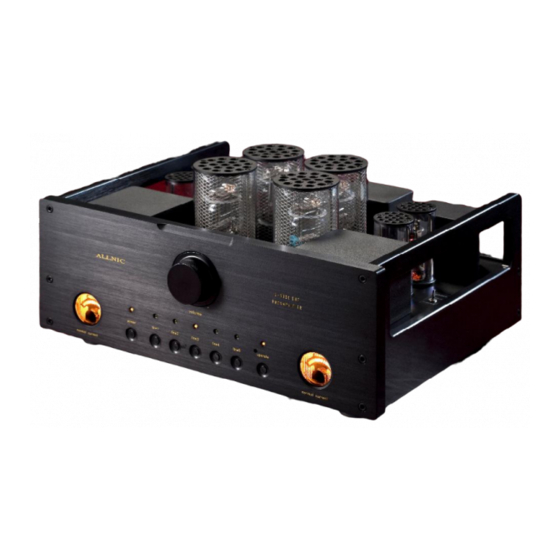ALLNIC AUDIO L-5000 DHT Owner's Manual - Page 8
Browse online or download pdf Owner's Manual for Amplifier ALLNIC AUDIO L-5000 DHT. ALLNIC AUDIO L-5000 DHT 14 pages. Line stage preamplifier

to each side of the Mute button (Please see Figure 4).
Control the volume level using the up (louder) and
down (quieter) arrow buttons above and below the
Mute button. After about forty (40) seconds, the light
above the "operate"/"mute" button will illuminate.
The L-5000 DHT has a "soft start" delay for the tubes
in order to extend tube life.
Mute the volume using the button labeled with a
speaker cone with an "X" across it, located between
the "CH" and "VOL" arrow buttons. Depressing the
mute button will run the volume control down to
zero. To raise the volume again after muting, press
the mute button to take the volume level to where it
was prior to muting.
There is no power on/off on the remote. The L-5000
DHT on/off control is on the face of the chassis only.
This should help prevent accidental powering off of
the L-5000 DHT when the power amps are still on.
INITIAL POWER-ON
Once you have your L-5000 DHT in place and all
connections have been made to your sources and
amplifier(s) and the power cord is installed and plugged
into an AC receptacle, you are ready to turn on the power
for your L-5000 DHT. Before you power up the L-5000 DHT,
though, be sure you have:
CAREFULLY AND SLOWLY removed ALL the cardboard
cushion materials from inside the tube chimneys
ensured the batteries are in the remote control – if
not, insert the batteries (by removing plate on the
bottom of the remote control).
selected the output connections that you want to use,
single ended (RCA) or balanced (XLR), on the switch at
top centre on the back of the preamplifier
turned the volume down on or muted the L-5000 DHT
checked that all your connections are snug
Also, be sure you have manually turned the volume control
on the front panel to the extreme counter-clockwise
position (minimum volume).
When the Allnic L-5000 DHT has powered up internally and
you have depressed the far left hand button marked
"power" on the front panel, the following will happen on
the front panel (Please see Figure 5):
the light above the "power" button will illuminate.
the meters on the front panel will illuminate.
the light over the line source button that is
depressed will illuminate
after about 40 seconds, the light over the mute
button will illuminate
The Allnic Audio L-5000 DHT is now ready for operation.
At this point, you can power on your stereo power
amplifier or mono-blocks.
OPERATION
From this point on, operation is straight-forward. All
functions are controlled from the front panel or the
remote control. Of course, BE CAREFUL about differences
in gain between your sources. Generally, disc players and
tuners will have greater gain than phono stages. That
means the volume setting for listening to your turntable
might be too high for listening to CD's.
To avoid surges to the speakers, it is best to change from
input to input only with the "operate" button set to mute
(the light above the button will not be illuminated when
the button is in the "mute" position).
When you are finished listening, turn off your stereo
power amplifier or mono-block amplifiers. Then turn off
the L-5000 DHT, using the remote control or depressing
the power switch on the front panel. The power switch
on the rear panel should stay in the "on" position – this
will keep key circuitry warm, and your L-5000 DHT will be
ready to play when the soft-start turns on the L-5000 DHT
next time you want to listen. Turn off your sources last.
THE CURRENT METERS
These illuminated meters indicate the current supply to
the gain tubes in the L-5000 DHT. They are indicators of
failure or damage to the function of the unit. There is one
meter for each channel. The needle should be between
the two parallel lines just left of centre on the meter face.
Any failure of the tubes or circuits in one or the other of
the L-5000 DHT's channels is indicated by the needle on
the meter for the respective channel moving out from
between those two parallel lines.
If the needle has moved to the left of the parallel
lines on a meter, it means that one or both of the
gain tubes (3A/110A or 3A/109B) for that channel
is failing.
If the needle on either meter moves to the right of
the parallel lines, it means that one or the other of
the rectifier or voltage regulator tubes (7233 or
6AK6) for that channel is failing.
8
